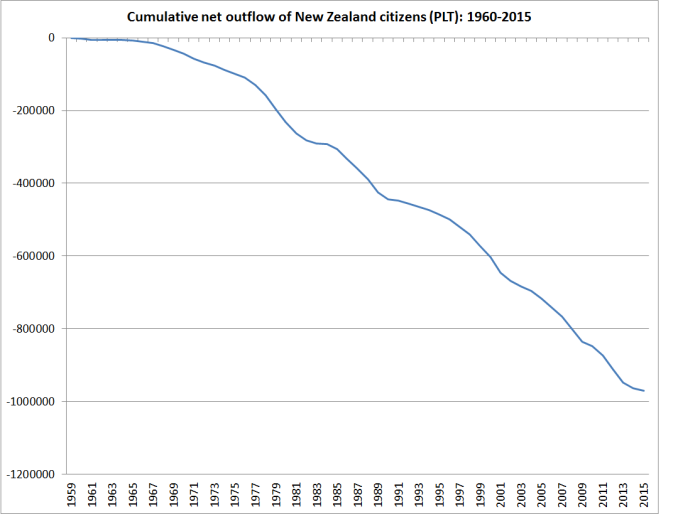Browsing on some blogs this morning, I stumbled on a nice brief article by Kevin O’Rourke, an Irish economic historian and professor at Oxford, about the role emigration from Europe in the 19th century may have played in enabling European populations to capture the benefits of the Industrial Revolution, and overcome the Malthusian limits, sooner than they might otherwise have done.
The article is worth reading, but my eye lighted on a single paragraph that summarized some results that I’d been meaning to write about for some time:
…emigration proved an invaluable safety valve. It was highest where wages were lowest relative to the New World, and where population growth was fastest, although poverty traps at first impeded migration from the poorest regions of Southern and Eastern Europe. And the beneficial effects on European labour markets and living standards were often very large. According to one estimate, between 1870 and 1910 emigration lowered the Swedish labour force by 20 per cent, and increased real wages by 7.5 per cent; the equivalent figures were 24 per cent and 10 per cent for Norway, 39 per cent and 28 per cent for Italy, and no less than 45 per cent and 32 per cent for Ireland.
These estimates aren’t by just anyone. They are the results of work done by two leading academics, Alan Taylor and Jeffrey Williamson, both of whom have spent decades looking at these and related issues.
In other words, emigration from (in these cases) Sweden, Norway, Italy and Ireland left the people who stayed behind better off – it contributed, in the jargon, to a process of factor price equalization, tending to narrow the gaps between wages in emerging Europe and places like the United States, Australia or New Zealand. Looked at through the perspective of history, it should not be a remotely surprising result to anyone. Wage differentials between New Zealand and the United Kingdom, for example, are estimated to have converged in the run-up to World War One, in response to the very large inward migration here.
But for some reason people get hesitant about applying the same logic to New Zealand’s experience over the last 40 years or so. Over that period, a large gap has opened up between wages and material living standards between New Zealand and the rest of the advanced world. But the gap has been particularly obvious in respect of Australia – obvious both because the two countries had had fairly similar incomes throughout their modern history, and because of the relatively free labour mobility between the two countries.
The cumulative net outflow of New Zealand citizens since 1960 is estimated to have exceeded 900000 people.

If the average population over that period was around 3.5 million, the outflow is roughly equal to a quarter of our population – so it has been on a scale similar to the countries in the extract above. All else equal, we might have expected quite a degree of factor price equalization to have occurred as a result, just as those European countries experienced in the 19th century. One wouldn’t have expected the process to be complete by any means – after all, incomes in (former ) East Germany are still below those in the West, and not everyone has left the East. But if economies were left to work normally, we’d have expected quite a lot of convergence.
But what really marked modern New Zealand out from 19th century Italy, Ireland, Sweden or Norway was immigration policy. As returns abroad improved relative to those at home, authorities in none of those four countries/regions (Ireland was still part of the United Kingdom) had an active policy to bring in even more migrants from elsewhere than were leaving.
For many, the emigration must have been heart-rending – breaking up families and depleting villages and regions. But it was a process of responding to changing opportunities that, on average, improved living standards for those who went to the New World and those who stayed behind. But the governments weren’t activist enough, or foolish enough, to prevent the adjustment working, or try to reverse it as a matter of policy. You can’t expect to see factor price equalization occurring, working in ways that help the poorer country/region, when (net) there isn’t an outflow of factors from the poorer region. If only New Zealand policymakers would recognize this rather basic, historically well-documented, point.
Fascinating. Were they all on the gold standard?
LikeLike
a mix of regimes, including Italy was part of the Latin monetary union. But none were on fiat money standards
LikeLike
Click to access jmp1110.pdf
LikeLike
Life was miserable and stagnant for most who lived before the Industrial Revolution. “The
average person in the world of 1800 was no better off than the average person of 100,000
BC” (Clark, 2008)
….
You have to be careful about that sort of observation: of 13 children captured by native Americans, all but 10(?) preferred the life of the native and proved difficult to repatriate.
” When an Indian Child has been brought up among us, taught our language and habituated to our Customs, yet if he goes to see his relations and make one Indian Ramble with them, there is no perswading him ever to return, and that this is not natural [to them] merely as Indians, but as men, is plain from this, that when white persons of either sex have been taken prisoners young by the Indians, and lived a while among them, tho’ ransomed by their Friends, and treated with all imaginable tenderness to prevail with them to stay among the English, yet in a Short time they become disgusted with our manner of life, and the care and pains that are necessary to support it, and take the first good Opportunity of escaping again into the Woods, from whence there is no reclaiming them.”
http://www.beliefnet.com/resourcelib/docs/180/Letter_to_Peter_Collinson_1.html
LikeLike